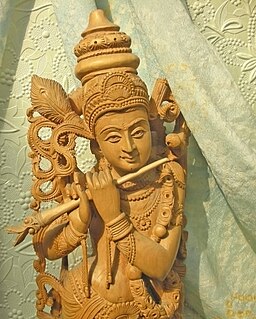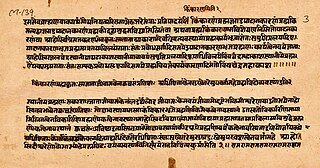
Lakshmi (लक्ष्मी) or Laxmi, is the Hindu goddess of wealth, fortune and prosperity. She is the wife and shakti (energy) of Vishnu, one of the principal deities of Hinduism and the Supreme Being in the Vaishnavism Tradition. With Parvati and Saraswati, she forms Tridevi, the holy trinity. Lakshmi is also an important deity in Jainism and found in Jain temples. Lakshmi has also been a goddess of abundance and fortune for Tamils and was represented on the oldest surviving stupas and cave temples of Hinduism. Goddess Lakshmi in Hinduism: The goddess of abundance and fortune, Sri Lakshmi, reflected the accumulated wealth and financial independence of the Tamil monasteries.
Bhakti yoga, also called Bhakti marga, is a spiritual path or spiritual practice within Hinduism focused on loving devotion towards a personal god. It is one of the paths in the spiritual practices of Hindus, others being Jnana yoga and Karma yoga. The tradition has ancient roots. Bhakti is mentioned in the Shvetashvatara Upanishad where it simply means participation, devotion and love for any endeavor. Bhakti yoga as one of three spiritual paths for salvation is discussed in depth by the Bhagavad Gita.

Vishishtadvaita is one of the most popular schools of the Vedanta school of Hindu philosophy. Vedanta literally means the end of the Vedas.VishishtAdvaita is a non-dualistic school of Vedanta philosophy. It is non-dualism of the qualified whole, in which Brahman alone exists, but is characterized by multiplicity. It can be described as qualified monism or qualified non-dualism or attributive monism. It is a school of Vedanta philosophy which believes in all diversity subsuming to an underlying unity.

Narayana, is known as Nirgun Bhram and is the creator of Tridevas-Bhrama(Divya Rajas),Vishnu(Divya Satya),and Mahesh(Divya Tamas). He is sometimes considered same as God Vishnu but is different as he is Nirguna and God Vishnu has Divya Satva Guna. He is also known as "The Purusha" and is considered Supreme in Yogic Tradition. He is also "Guru of the Universe". The Bhagavata Purana and Veda declares Narayana as a part of the Trimurti who creates unlimited universes and enters each one of them..
Saguna Brahman came from the Sanskrit saguṇa (सगुण) "with qualities, gunas" and Brahman (ब्रह्मन्) "the Absolute", close to the concept of immanence, the manifested divine presence.

The Bhagavad-Gītā As It Is is a translation and commentary of the Bhagavad Gita, by A. C. Bhaktivedanta Swami Prabhupada, founder of the International Society for Krishna Consciousness (ISKCON), commonly known as the Hare Krishna movement. The Bhagavad Gita emphasizes a path of devotion toward the personal God, Krishna. It was first published in 1968 by Macmillan Publishers and is now available in nearly sixty languages and is primarily promoted and distributed by followers of ISKCON. Prabhupada's translation and commentaries of the Bhagavad-Gītā As It Is is considered by adherents to the ISKCON movement and many Vedic scholars to be one of the finest literary works of Vaishnavism translated into English.
Paramatman or Paramātmā is the Absolute Atman, or supreme Self, in various philosophies such as the Vedanta and Yoga schools in Hindu theology, as well as other Indian religions like Sikhism. The Paramatman is the “Primordial Self” or the “Self Beyond” who is spiritually practically identical with the Absolute, identical with the Brahman. Selflessness is the attribute of Paramatman, where all personality/individuality vanishes.

Madhava is one of the primary names of Krishna, the All-attractive. Infact, Krishna attracts all beings due to His Four Madhuris, the eternal sweetnesses, namely, Venu-madhuri, Roop-madhuri, Lila-madhuri and Raas-madhuri. These four eternal sweetnesses are not manifested in any other manifestations of Krishna. These madhuris of Madhava also attracted Lord Mahavishnu Ref: Srimad Bhagvatam chapter # 89/10.

In Hinduism, there are diverse approaches to conceptualizing God and gender. Many Hindus focus upon impersonal Absolute (Brahman) which is genderless. Other Hindu traditions conceive God as androgynous, alternatively as either male or female, while cherishing gender henotheism, that is without denying the existence of other Gods in either gender.

Pranava yoga is meditation on the sacred mantra Om, as outlined in the Upanishads, the Bhagavad Gita, and the Yoga Sutras of Patanjali. It is also called Aum yoga and Aum yoga meditation. It is, simply put, fixing the mind on the sound of the mantra “Aum” – the sacred syllable that both symbolizes and embodies Brahman, the Absolute Reality – as the mantra is constantly repeated in unison with the breath. The purpose of pranava yoga is to become free from suffering and limitation.
Svayam Bhagavān is a Sanskrit theological term for the concept of absolute representation of God as Bhagavan - The Supreme Personality who possesses all riches, all strength, all fame, all beauty, all knowledge and all renunciation.

The Bhagavad Gita, often referred to as the Gita, is a 700-verse Sanskrit scripture that is part of the Hindu epic Mahabharata.

Achintya-Bheda-Abheda is a school of Vedanta representing the philosophy of inconceivable one-ness and difference. In Sanskrit achintya means 'inconceivable', bheda translates as 'difference', and abheda translates as 'non-difference'. The Gaudiya Vaishnava religious tradition employs the term in relation to the relationship of creation and creator, between God and his energies. It is believed that this philosophy was taught by the movement's theological founder Chaitanya Mahaprabhu and differentiates the Gaudiya tradition from the other Vaishnava Sampradayas. It can be understood as an integration of the strict dualist (dvaita) theology of Madhvacharya and the qualified monism (vishishtadvaita) of Ramanuja.
Avyakta, meaning "not manifest", "devoid of form" etc., is the word ordinarily used to denote Prakrti on account of subtleness of its nature and is also used to denote Brahman who is the subtlest of all and who by virtue of that subtlety is the ultimate support (asraya) of Prakrti. Avyakta as a category along with Mahat and Purusa plays an important role in the later Samkhya philosophy even though the Bhagavad Gita III.42 retaining the psychological categories altogether drops out the Mahat and the Avyakta (Unmanifest), the two objective categories.
Ekāgratā is intent pursuit of one object, close and undisturbed attention. Yoga emphasises regular practice (Abhyasa) meditation and self-imposed discipline to acquire ekagrata.
Tyāga is a Sanskrit word that means "sacrifice, giving up in generosity, forsaking, resigning" anything of value, as well as "renunciation" depending on the context. It is an ethical concept in Hinduism and Jainism.
Kshetrajna means the One who knows of the body, soul, spirituality, conscious principle in the corporeal frame. In the thirteenth chapter of the Bhagavad Gita, Krishna explains the distinction between the Kshetra (known) and the Kshetrajna (knower).
Divya-drishti or the divine eye-sight, also known as Yoga-drishti, refers to 'divine perception' which is intuitive perception or cognition that carries with it an intrinsic certainty and conviction. It is a spiritual attainment which according to Patanjali enables the yogi to communicate with heavenly bodies. This Divine vision is gained by the practice of neti that balances the flow of prana-shakti in ida, pingala and sushmana and uplifts the higher mental faculties which awaken the chakras and kundalini and even enables the yogi to see into the past and future. "Uttitha padma āsana" makes one develop divya-drishti, opens the heart center and cures respiratory disorders.


















